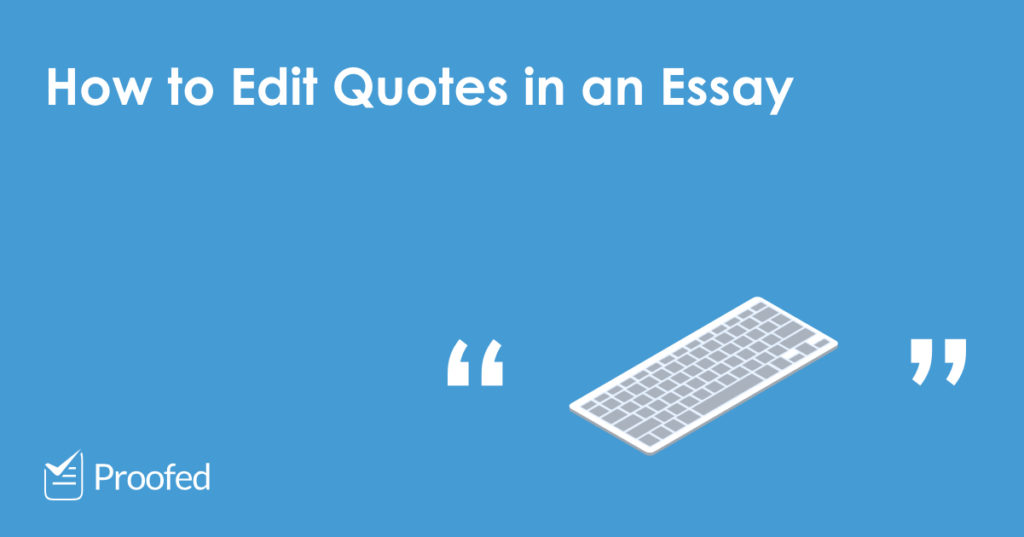Quoting sources is vital when writing an essay. But what if the quote doesn’t fit the surrounding text? Or what if it’s too long?
The good news is you can change a quote if you need to. But you also need to highlight your edits clearly in the text. Check out our guide below, then, to find out how to edit quotes in academic writing.
Omitting Text from Quotations with Ellipses
If a quote is too long, it may interrupt the flow of your writing. For instance:
Smith (2007, p. 24) describes blancmange as “a sweet dessert that is generally made with milk or cream and sugar, although I also once had one that contained none of these ingredients, that has been thickened with gelatin, corn starch or Irish moss.”
The middle part of this quote isn’t necessary for describing blancmange, so we might want to leave it out. To do this, we would use an ellipsis to show where we had cut something from the original source:
Smith (2007, p. 24) describes blancmange as “a sweet dessert that is generally made with milk or cream and sugar…that has been thickened with gelatin, corn starch or Irish moss.”
We now have the text we wanted to quote, but we haven’t had to include the middle bit. This makes it clearer and more succinct.
Keep in mind, too, that you can write an ellipsis in several ways, including:
- In square brackets […]
- Spaced (. . .) or unspaced (…)
- With a space before and after the ellipsis or without spaces
As such, always check your style guide for advice on how to write ellipses. If you do not have a style guide, simply apply one type of ellipsis consistently.
Changing or Adding Words in Quotations
You can edit quotes by changing or adding words in order to:
- Integrate quoted text into your own writing
- Clarify the meaning of something
- Correct an error in the original text
If you do any of these, use square brackets to show where you have changed the original text. For example, imagine we found the following in a book:
Blancmange is delicious. The first time I ate it, I was in love.
Find this useful?
Subscribe to our newsletter and get writing tips from our editors straight to your inbox.
We might then want to quote the second sentence. But without the first sentence, it wouldn’t be clear what the “it” refers to. As such, we could edit the second sentence so that it works by itself:
Smith (2007, p. 31) says, “The first time I ate [blancmange], I was in love.”
It is now clear what Smith is saying without having to include the first sentence, but the reader can also see where we have changed the quote.
Marking Errors in Quotations
Finally, what if you don’t want to change an error in a quote? Or what if it contains something that looks like an error, such as an old-fashioned spelling?
In cases like these, you can use the Latin term “sic” to show that you’ve kept something non-standard from the original text. This is short for sic erat scriptum, which translates to “thus was it written.”
Usually, to use “sic” like this, you would place it in square brackets:
His writings were riddled with errors due to his addiction, which he described as “a terrible but delishus [sic] shame” (Smith 2017, p. 2).
The reader will then know that the spelling “delishus” comes from the quoted text, so it is not a transcription error.
Unless you have a good reason for preserving an error, though, it is usually better to fix it and put the correction in square brackets instead.
Summary: How to Edit Quotes in an Essay
If you need to edit quotes in your writing, keep the following in mind:
- Use an ellipsis to indicate omissions in the text. Check your style guide for how to format ellipses (e.g., in brackets or not, spaced or unspaced).
- Mark additions or changes by placing the edited text in square brackets.
- Use the term “[Sic]” to show that you’ve duplicated an error from a source. This will ensure the reader doesn’t think you’ve made a mistake yourself.
Different style guides may vary on these rules, so make sure to check yours if you have one. And don’t forget to have your work proofread.
